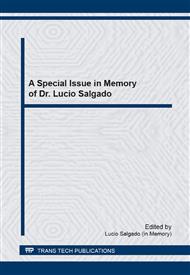p.621
p.627
p.632
p.641
p.646
p.651
p.657
p.662
p.667
Preparation of Zeolite MCM-22 Using the Rice Husk Ash as Silica Source
Abstract:
Brazil is a great producer of rice generating large amounts of husks after rice processing. These hulls contain high percentage of SiO2, and a great potential as raw material for the development of silica based materials, as zeolites. Thus, this work aims to use the silica of rice hulls as an alternative raw material for the production of zeolite MCM-22. This material was characterized through X-ray diffraction, X-ray spectrophotometry and physical adsorption of N2 (BET). The diffraction pattern of precursor MCM-22 presented typical peaks of topology MWW. Calcined sample did not presented peaks related with the organic material used in of the zeolite MCM-22, indicating that the thermal treatment was efficient for organic removal. It was confirmed, through the EDX, that the synthesized materials present high amount of SiO2 and low quantity of Al2O3. The BET isotherms indicated that the materials presented structures with microporous, concluding that the alternative silica was promisingly for the development of zeolites.
Info:
Periodical:
Pages:
646-650
Citation:
Online since:
September 2014
Keywords:
Price:
Сopyright:
© 2015 Trans Tech Publications Ltd. All Rights Reserved
Share:
Citation:


